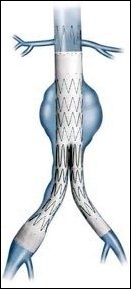EVAR

What is an EVAR or Aortic Stent Graft?
An Aortic Stent Graft is an endovascular technique used to treat thoracic or abdominal aortic aneurysms.
Why do I need an Aortic Stent Graft?
You have been referred from your Vascular Surgeon who has been looking after you with your aneurysm. An aneurysm is an enlargement of the normal blood vessel. Aneurysms usually don’t cause any symptoms but there is a risk of the aneurysm rupturing. Once your aneurysm gets beyond a specific size, the risk of rupture increases.
Aneurysms may also be treated by your Vascular Surgeon during an Open Repair. Some aneurysms are more suitable for treatment with an Aortic Stent Graft rather than an Open Repair and your Vascular Surgeon or Radiologist will discuss this with you.
Who has made the decision?
The Vascular Surgeon in charge of your case and the Radiologist doing the Aortic Stent Graft have discussed your case and reviewed any previous images you may have had (usually a CT scan). You will also have the opportunity for your opinion to be taken into account, and if, after discussion with your doctors, you do not want the procedure carried out, you can decide against it.
Who will be doing the Aortic Stent Graft?
A specially trained Radiologist with the assistance of your Vascular Surgeon will perform the Stent Graft Procedure.
How do I prepare for an Aortic Stent Graft?
You will be prepared for an operation and will be kept nil by mouth for 6 hours prior to the procedure. In most cases you will have a general anaesthetic for the procedure.
If you have any allergies, you must let your doctor know. If you have previously reacted to intravenous contrast medium (the dye used for kidney x-rays and CT scans), you must also tell your doctor about this.
What happens during an Aortic Stent Graft?
You will lie on the x-ray table, under general anaesthesia. You will have a needle or cannula put into a vein in your arm, so that the anaesthetist can give you any medicines needed for the anaesthetic.
The Vascular Surgeon will make incisions in both of your groins for the Stent Graft device to pass through the arteries, The Radiologist will pass a guide-wire through your arteries to the aneurysm and pass the stent graft device through your arteries over the guide-wire.
The Radiologist uses the x-ray equipment to make sure that the Stent Graft and the guide-wire are moved into the right position. Once the Radiologist is happy with the position of the Stent Graft, the graft is deployed.
At the end of the procedure, the Vascular Surgeon will repair the artery and stitch up the groin incisions.
Will it hurt?
Some discomfort may be felt in the skin and deeper tissues following the procedure.
How long will it take?
Every patient’s situation is different, and it is not always easy to predict how complex or how straightforward the procedure will be. As a guide, the procedure usually takes about 2-3 hours.
What happens next?
You will be taken back to the recovery room to wake up from the anaesthetic. Nurses will carry out routine observations, such as taking your pulse and blood pressure, to make sure that there are no problems. They will also look at the skin entry point to make sure there is no bleeding from it. You will generally stay in bed for a few hours, until you have recovered. You may be allowed home on the same day, or kept in hospital overnight.
Are there any risks or complications?
An Aortic Stent Graft is a safe procedure, but there are some risks and complications that can arise. There may be bruising around the groins following the operation. There may be complications if the position of the Stent Graft is not ideal. Your Radiologist will discuss these risks with you.
What happens afterwards?
A CT scan will be performed on the day following your Aortic Stent Graft placement. This is to check the position of the stent graft. If the Radiologist is happy with the scan, you will be discharged from hospital the following day. You will have further follow-up scans at 3 months, 6 months and then annually, just to keep a check on the aneurysm and the Stent Graft.
Finally...
Some of your questions should have been answered by this page, but remember that this is only a starting point for discussion about your treatment with the doctors looking after you.
© The Royal College of Radiologists
Contact Us for more information

